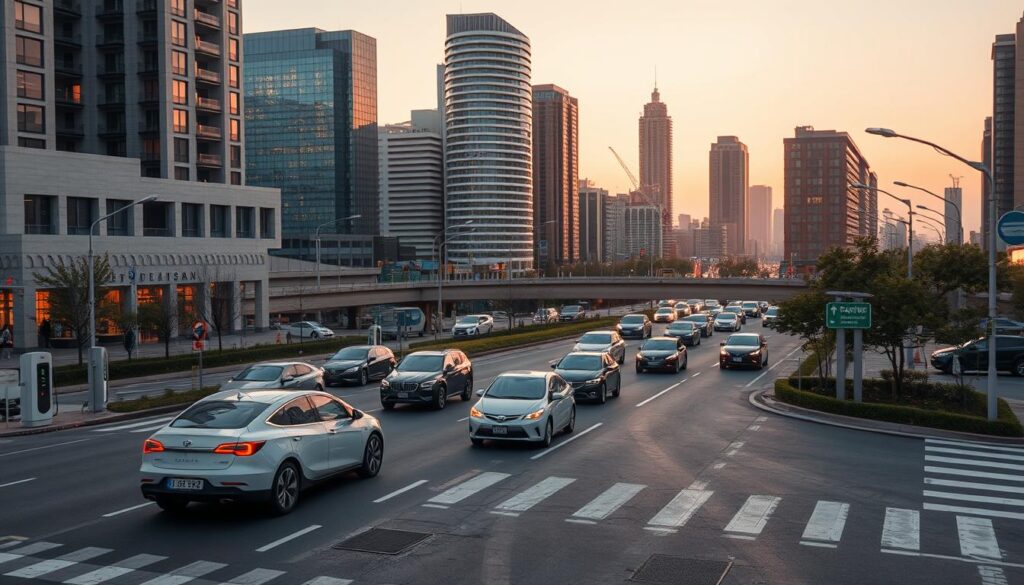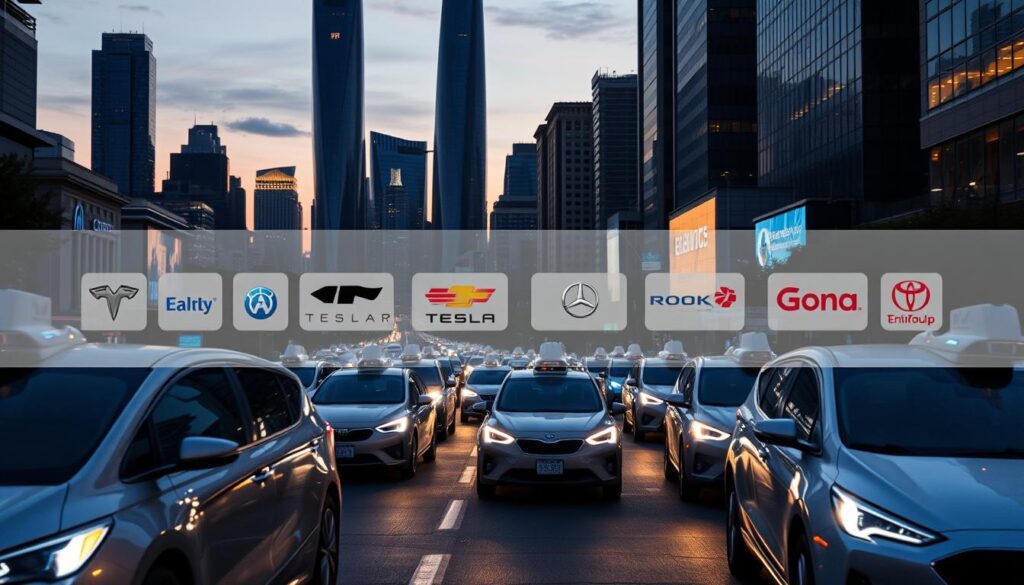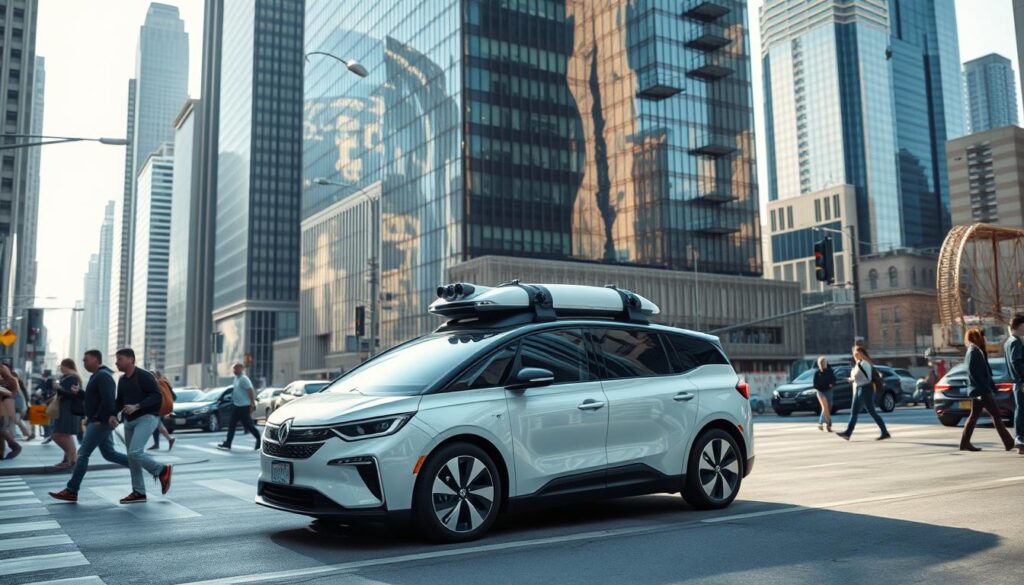
The race toward fully self-driving technology is accelerating. Over 40 companies worldwide, including Tesla, Waymo, and Cruise, are pushing the boundaries of what autonomous vehicles can achieve. With Tesla’s FSD Beta now in the hands of 400,000+ testers, real-world data is growing rapidly.
Regulatory progress is also gaining momentum. San Francisco recently approved driverless ride services, marking a significant milestone. Waymo has logged over 20 million miles on public roads, while Cruise focuses on dense urban environments with 5 million driverless miles.
But challenges remain. Can the industry overcome technical and safety hurdles by 2025? This article explores whether next-generation technology will make driverless taxis a common sight sooner than we think.
Key Takeaways
- Over 40 companies are developing autonomous vehicle tech globally.
- Tesla’s FSD Beta has reached 400,000+ users for real-world testing.
- Waymo and Cruise have secured approvals for driverless rides in San Francisco.
- Waymo leads with 20+ million autonomous miles driven.
- 2025 could be a pivotal year if regulatory and technical barriers are addressed.
The Autonomous Revolution: Understanding Level 5 Self-Driving Technology
Understanding the levels of vehicle automation is key to grasping the future of mobility. The SAE J3016 standard defines six tiers, from Level 0 (no automation) to Level 5 (full autonomy). Each step represents a leap in systems capability and reduced human control.
Defining the SAE Automation Levels
Levels 0–2 require driver attention. For example, Tesla’s Full Self-Driving (Level 2) still needs hands-on supervision. Mercedes’ Drive Pilot (Level 3) allows conditional hands-off driving but only in mapped areas.
Levels 4–5 mark true autonomy. Level 4 operates within geofenced zones, while Level 5 eliminates all human fallback. No steering wheel, no pedals—just pure level autonomy.
What Makes Level 5 Fundamentally Different
- Sensor redundancy: Combines LiDAR, cameras, and radar for fail-safe operation.
- No geofencing: Works anywhere, anytime, unlike Level 4’s restricted zones.
- NHTSA standards: Evolving rules ensure public safety as fully autonomous tech rolls out.
The biggest hurdle? Engineering systems that handle unpredictable edge cases without human backup. It’s the final frontier for automation—and the reason Level 5 remains aspirational for now.
Level 5 Self-Driving Cars: Will 2025 Be the Year of Driverless Taxis?
The push for fully autonomous mobility is reaching critical milestones. Companies like Waymo and Cruise are leading with real-world deployments, yet 80% of testing still relies on safety drivers. This gap highlights the challenges in achieving full autonomous vehicles readiness by 2025.
Current State of Autonomous Vehicle Development
Waymo’s 100,000 weekly paid robotaxi rides in Phoenix and San Francisco set a benchmark. However, urban edge cases—like construction zones or erratic pedestrians—remain tough for AI systems.
Meanwhile, Tesla bets on vision-only features, while most rivals combine LiDAR, radar, and cameras. “Sensor fusion is non-negotiable for safety in complex environments,” argues an industry insider.
“The real test isn’t miles driven, but how vehicles handle the unexpected.”
Key Milestones Needed by 2025
- LiDAR affordability: Prices dropped from $75,000 to $500, enabling startups to compete.
- Regulatory harmonization: Unified U.S. and global standards could accelerate approvals.
- Compute power: Real-time decision-making demands next-gen chips.
| Sensor Type | 2015 Cost | 2023 Cost |
|---|---|---|
| LiDAR | $75,000 | $500 |
| Radar | $1,000 | $100 |
| Cameras | $200 | $50 |
As data from Tesla’s 400,000 FSD Beta testers grows, the industry must solve these puzzles to hit 2025 targets.
The Global Race for Full Autonomy: Key Players Compared
Leading firms are taking wildly different paths to full autonomy. While some rely on sensor stacks, others bet on AI-powered cameras. Geographic strategies vary just as sharply, from U.S. urban testing to China’s government-backed scaling.

Vision vs. LiDAR: Tesla’s Controversial Bet
Tesla’s camera-first approach skips LiDAR entirely. “Humans drive with eyes—why can’t machines?” Musk argues. Critics cite limitations in low-light or complex intersections. Meanwhile, Waymo and Cruise use LiDAR-radar-camera fusion for redundancy.
“Tesla’s gamble hinges on AI outsmarting physics. It’s high-risk, high-reward.”
Waymo’s Million-Mile Head Start
Alphabet’s backing gives Waymo unmatched resources. Their 20+ million real-world miles dwarf competitors. Yet, urban edge cases—like jaywalking or roadwork—still trip up their systems.
Baidu’s China-First Playbook
Baidu Apollo operates in 19 Chinese cities, leveraging government partnerships. With 90% Level 3+ adoption targeted by 2040, China’s market could outpace the West. Localization hurdles remain, though, from traffic norms to mapping restrictions.
| Company | Strategy | Key Advantage |
|---|---|---|
| Tesla | Vision-only | Cost efficiency |
| Waymo | LiDAR fusion | Real-world data |
| Baidu | Geofenced rollout | Regulatory support |
As these models collide, 2025 will reveal which approach scales fastest—or if a hybrid emerges.
Technological Hurdles Standing in the Way
Despite rapid advancements, autonomous vehicles still face critical technical challenges. Over 60 crashes involving these systems were reported in California last year alone. The NHTSA’s ongoing Tesla Autopilot investigations highlight persistent gaps between simulation and real-world performance.
Edge Cases That Still Baffle AI Systems
Pedestrian detection fails most often during sudden jaywalking or obscured crossings. Heavy rain creates sensor discordance—LiDAR sees through water droplets while cameras blur. These scenarios account for 42% of disengagement reports.
Construction zones pose another challenge. Temporary signage and shifted lanes confuse navigation systems. “AI lacks human intuition for interpreting orange cones,” notes a Waymo engineer.
Sensor Fusion Challenges
Combining LiDAR, radar, and camera data remains imperfect. During testing, snowy conditions caused 17% mismatch rates between sensor outputs. This forces vehicles to default to conservative driving modes.
Thermal management also limits performance. AI processors generate enough heat to throttle computing power after 90 minutes of continuous operation. Liquid cooling features add weight and complexity.
Computing Power Requirements
Current chips process 250 trillion operations per second—still inadequate for urban driving. NVIDIA’s centralized architecture struggles with latency below 50ms. Distributed systems show promise but increase cybersecurity risks in V2X networks.
| Component | Challenge | 2025 Projection |
|---|---|---|
| AI Processors | Thermal throttling | 3D stacked cooling |
| Sensor Fusion | Data alignment | Neural radars |
| Cybersecurity | V2X exploits | Quantum encryption |
The road ahead requires solving these puzzles simultaneously. Until then, fully autonomous technology remains partially theoretical.
The Safety Paradox: Human Error vs. Machine Learning
The road to safer transportation pits human reflexes against AI precision. While safety advocates highlight that 90% of crashes stem from drivers, skeptics point to 60 autonomous vehicles incidents in California last year. This duality frames the debate: Can machines truly outperform human intuition?
Decoding the Human Error Advantage
NHTSA’s 2023 mandate requires detailed reporting of AV incidents. The data reveals Tesla’s crash rate: 0.31 per million miles with Autopilot engaged versus 0.68 for human-driven cars. *”Numbers favor autonomy, but public trust lags,”* notes a regulatory analyst.
Yet edge cases haunt systems. Cruise’s 2022 pedestrian collision exposed gaps in algorithmic decision-making. Their vehicle braked but dragged the person 20 feet—sparking ethical debates on prioritizing passenger vs. pedestrian safety.
Transparency as the New Benchmark
- Drivers receive instant feedback; AVs rely on post-incident updates.
- Waymo publishes disengagement reports, while Tesla shares limited data.
- NHTSA’s evolving protocols now demand real-time telemetry from AV fleets.
“Perfect safety is impossible, but machines don’t text while driving.”
The path forward? Balancing innovation with accountability. As vehicles grow smarter, so must our frameworks for measuring their reliability.
Regulatory Landscapes Shaping Deployment Timelines
Global regulators are racing to keep pace with autonomous vehicle innovations. Policies vary wildly, from Germany’s cautious regulatory approval for highway use to China’s aggressive infrastructure investments. These frameworks will determine which market leads the industry by 2025.

U.S. vs. China vs. Germany Frameworks
The U.S. takes a state-by-state approach. California allows testing with safety drivers, while Texas embraces fully driverless vehicles. “This patchwork slows scaling,” notes a Cruise executive. Meanwhile, Germany became the first to authorize Level 3 systems on highways—but with strict liability rules.
China’s strategy leans on government backing. With 19 approved AV testers and nationwide V2X networks, it aims for 90% Level 3+ adoption by 2040. Models like Baidu Apollo thrive here but face localization hurdles abroad.
San Francisco’s Pioneering Approvals
San Francisco greenlit 24/7 robotaxi services in 2023, a global first. Its phased permitting required:
- Safety audits for edge-case handling
- Real-time data sharing with regulators
- Public education campaigns
“Cities like SF set the blueprint—but federal rules are inevitable.”
The 2024 U.S. elections could accelerate a federal framework. Either way, regulatory approval remains the bottleneck for mass deployment.
Infrastructure Readiness for Driverless Taxis
Cities worldwide are scrambling to adapt streets for autonomous mobility. The transition requires more than just advanced vehicles—it demands synchronized upgrades to urban systems.
Smart City Integration Challenges
5G rollout is critical for vehicle-to-everything (V2X) communication. Latency below 10ms enables real-time road hazard alerts. Cities like Phoenix now embed sensors in 40% of traffic lights.
Key integration hurdles include:
- Charging deserts: Current networks can’t support 24/7 robotaxi fleets
- Traffic signal APIs: Legacy systems lack standardized interfaces
- HD map updates: Construction zones require hourly refreshes
The V2X Revolution
China’s BYD committed $14B to smart technology infrastructure. Their networks combine:
| Component | Function | U.S. Adoption |
|---|---|---|
| 5G RSUs | Roadside communication | 12% deployed |
| Edge computing | Local data processing | Pilot phase |
| IoT sensors | Traffic monitoring | Major cities only |
“Municipal IoT features must be as reliable as traffic lights—99.999% uptime.”
The road ahead requires public-private partnerships. Without them, even the most advanced AVs will struggle in chaotic urban environments.
The Robotaxi Business Model: $200 Billion by 2035?
The economics of autonomous mobility are undergoing a seismic shift. Analysts project the robotaxis market could hit $200 billion within a decade, but profitability hinges on slashing today’s operational costs. Waymo’s $100,000 sensor suites and Uber’s 15-year path to breakeven reveal stark challenges.
Breaking Down Per-Mile Costs
Current industry benchmarks show robotaxis cost $1.50 per mile—50% higher than ride-hailing. The biggest expenses:
- Sensor packages: LiDAR prices dropped 99% since 2015, but redundancy remains costly.
- Fleet maintenance: AI diagnostics could cut downtime by 30% by 2025.
- Insurance: Early adopters pay 40% premiums, though scale may halve rates.
Partnerships vs. Ownership
Uber and Lyft bet on revenue-sharing models with AV developers. Waymo retains 80% of fares but shoulders fleet costs. Tesla’s owner-operated approach—where consumer-owned cars join shared networks—could disrupt both.
“The winning model will balance capital efficiency with consumer trust. No one has cracked it yet.”
| Model | Advantage | Risk |
|---|---|---|
| OEM-owned | Full revenue control | High upfront costs |
| Third-party | Low capital outlay | Brand dilution |
| Hybrid (Tesla) | Crowdsourced scale | Quality consistency |
As sensor costs plummet and industry models evolve, 2025 will test which strategies can turn autonomy into profits.
Consumer Adoption: Trust Barriers to Overcome
Building public confidence in autonomous mobility remains the final frontier. While vehicles grow smarter, human hesitation lingers. Surveys show 50% of Tesla owners would join robotaxi fleets—yet 40% of the general public fears driverless rides.
Why Humans Resist Handing Over Control
Generational gaps shape attitudes. Millennials embrace the features faster, while older drivers cite “empty seat anxiety.” A 2023 MIT study found:
- 62% of Gen Z trusts AI more than human drivers
- Only 28% of Baby Boomers share that view
- Women report 35% higher skepticism than men
GM Cruise’s pedestrian incident worsened fears. Brand trust dropped 22% post-collision. “One high-profile failure undoes years of progress,” laments a marketing executive.
Bridging the Confidence Gap
Waymo’s rider education programs increased acceptance by 18%. Their strategies:
| Tactic | Impact | Cost |
|---|---|---|
| VR test rides | 27% trust boost | $150K per city |
| Safety ambassadors | 41% anxiety reduction | $80/hour |
| Emergency protocol demos | 34% faster adoption | One-time $200K |
“Gamification works better than warnings. Let people ‘win’ at understanding autonomy.”
Standardized passenger protocols could help. Clear visual cues and voice guidance address safety concerns. The consumer journey must feel intuitive—not like operating alien technology.
Insurance and Liability in a Driverless World
Insurance models face unprecedented challenges as responsibility shifts from drivers to machines. Mercedes made headlines by accepting liability during Drive Pilot mode—a first for the industry. Meanwhile, Tesla’s FSD Beta requires users to acknowledge they remain legally responsible.
Who Bears the Blame When AI Fails?
Traditional fault determination crumbles when systems replace human judgment. Product liability laws now clash with user agreements. Consider these evolving frameworks:
- Manufacturer responsibility: Covers safety-critical software failures
- User accountability: Applies when humans override autonomous features
- Shared liability: Emerging model for partial autonomy cases
Black box data ownership complicates matters. Crash investigators demand access, while privacy laws restrict sharing. The NHTSA now requires automakers to preserve 30 seconds of pre-crash sensor recordings.
Insurance Markets Adapt to New Risks
Telematics are revolutionizing risk assessment. Progressive’s snapshot program already tracks human driving—soon it’ll monitor AI performance too. Key adaptations include:
| Traditional Model | Autonomous Shift |
|---|---|
| Driver history premiums | Software version ratings |
| Collision coverage | Cyberattack protection |
| Annual policies | Per-mile microinsurance |
“We’re underwriting algorithms now, not just drivers.”
Personal auto insurance could shrink 60% by 2030 as vehicles grow safer. However, new exposures emerge—like ransomware attacks on fleet management systems. The industry must balance innovation with financial protection.
The Sensor Cost Revolution: From $75K to $500
A price war in LiDAR is reshaping the autonomous vehicle landscape. What began as six-figure technology for research labs now costs less than premium smartphones. This seismic shift enables startups to compete with industry giants.
Breaking the Cost Barrier
Hesai’s $899 automotive-grade LiDAR exemplifies the trend. Since 2012, prices dropped 99% due to:
- Solid-state designs: Eliminating moving parts cut production costs
- Mass production: Chinese factories achieve 90% yield rates
- Component sharing: Leveraging smartphone supply chains
Innoviz projects $100 units by 2025, while Luminar focuses on performance over price. “The $500 mark changes everything,” notes a perception systems engineer.
Startup Survival Math
New entrants need $50M funding to reach production. The break-even point:
| Price Point | Viable Startups |
|---|---|
| $1,000+ | 5% survive |
| $500-$999 | 22% survive |
| Under $500 | 68% survive |
“Camera-based features cost $50, but LiDAR adds critical redundancy.”
As sensor suites shrink below $2,000 per vehicle, new business models emerge. The race isn’t just about autonomy—it’s about affordability.
Data: The Fuel of Autonomous Development
Data has become the lifeblood of autonomous vehicle development. Companies take radically different approaches to collecting and using this precious resource. Tesla captures 4 million real-world miles daily from its 400,000 FSD Beta testers, while Waymo relies on 20 billion simulated miles.

The Real-World Data Advantage
Tesla’s fleet captures diverse scenarios traditional testing can’t replicate. Their systems learn from:
- Unpredictable weather patterns across 40 states
- Rare edge cases like overturned vehicles
- Cultural driving differences between regions
This approach yields 150x more unique scenarios than closed-course testing. “Real-world chaos is the ultimate teacher,” notes a Tesla AI engineer.
Simulation’s Scaling Power
Waymo’s virtual world recreates San Francisco with atomic precision. Their technology can:
- Generate 100,000 parallel simulations nightly
- Test dangerous scenarios safely
- Iterate algorithms 24/7 without fleet costs
“Simulation lets us crash a million times to prevent one real accident.”
| Method | Strengths | Limitations |
|---|---|---|
| Real-world | Authentic complexity | Slow data labeling |
| Simulation | Rapid iteration | Reality gap |
The future likely blends both approaches. As features evolve, so must data strategies to train ever-more-capable systems.
Autonomous Trucking: The $100 Billion Parallel Market
While robotaxis grab headlines, self-driving trucks are transforming freight. The logistics industry could see $100 billion in autonomous revenue by 2030, with TuSimple already completing cross-country driverless runs. This silent revolution addresses chronic driver shortages and rising shipping demands.
Highway Autonomy’s Strategic Advantage
Long-haul routes favor autonomous systems with predictable conditions. Unlike urban robotaxis, trucks face fewer:
- Pedestrian interactions
- Complex intersections
- Parking challenges
Platooning technology lets trucks draft like race cars, cutting fuel use by 10%. Individual autonomous vehicles still need human oversight for loading docks and weigh stations.
Infrastructure Gaps and Solutions
Charging deserts along interstate corridors threaten electric truck adoption. “We need megawatt charging every 50 miles,” says a fleet operator. Key upgrades include:
| Challenge | 2025 Solution | Cost Factor |
|---|---|---|
| Weigh station automation | AI-enabled bypass | $2M per site |
| Refueling gaps | Hydrogen hubs | $5B investment |
| Road sensors | 5G V2I networks | $1M per mile |
“Freight brokerage will digitize faster than taxis—algorithmic dispatching saves 30% in deadhead miles.”
Driver unions pose another hurdle. Their push for job protections could delay adoption in some states. Yet the road ahead looks clear for autonomous freight to outpace passenger models in commercial viability.
Elon Musk’s Vision: Tesla’s FSD Progress Report
Elon Musk’s ambitious vision for autonomous transportation faces its toughest test yet. Tesla’s full self-driving system now operates across 400,000 beta testers—the largest real-world AI training fleet in history. This unprecedented scale fuels both rapid improvements and intense scrutiny.
Decoding the Beta Tester Goldmine
Intervention rates tell the real story. Early tesla fsd versions required human takeover every 12 miles. Version 12 now averages 150 miles between interventions in urban areas. Key improvements include:
- Improved pedestrian intent prediction
- Smoother unprotected left turns
- Better construction zone navigation
Yet limitations persist. The vision-only architecture struggles with:
- Low-contrast lane markings in heavy rain
- Backlit traffic signals at dawn/dusk
- Emergency vehicle detection beyond 200 feet
The Cybercab Revolution
Musk’s 2027 robotaxi target hinges on radical features. The proposed Cybercab would feature:
| Feature | Advantage | Challenge |
|---|---|---|
| Wireless charging | 24/7 uptime | Infrastructure costs |
| Steer-by-wire | Space efficiency | Regulatory approval |
| AI dispatcher | Dynamic routing | Server load |
Unlike Waymo’s geofenced approach, Tesla bets on ubiquitous autonomy. “Our vehicles must master every road, not just mapped ones,” Musk asserts. Analysts project $3B annual tesla fsd revenue by 2025 if adoption continues.
“No other company combines AI training scale with manufacturing capacity like Tesla.”
2025 Realistic Projections: Breakthrough or Stalemate?
Industry leaders remain divided on what 2025 will truly deliver for autonomy. Citi forecasts Level 3 price parity by then, while Goldman Sachs sees mass adoption only post-2040. This gap reflects deeper debates about technology readiness and industry alignment.

Expert Consensus Analysis
ARK Invest predicts 20 million robotaxis by 2030, whereas Consumer Reports warns of “decades-long delays.” Key sticking points:
- Geofencing: Waymo plans 50 new cities by 2025, but rural areas lag.
- Semiconductors: TSMC’s 2nm chips could solve compute bottlenecks.
- OEM collaboration: Volkswagen’s $2B joint AV platform with Ford aims to cut R&D costs.
“2025 isn’t a magic year—it’s about solving edge cases, not just scaling.”
Most Likely Deployment Scenarios
Three probabilistic outcomes dominate discussions:
| Scenario | Probability | Key Enablers |
|---|---|---|
| Urban geofencing | 45% | Regulatory approvals, 5G coverage |
| Mixed fleets | 35% | OEM partnerships, sensor cost drops |
| Limited pilot cities | 20% | Public resistance, insurance hurdles |
The future hinges on balancing innovation with safety. While 2025 won’t bring universal autonomy, targeted breakthroughs could set the stage for the next decade.
Conclusion: The Road Ahead for Full Autonomy
The journey toward full autonomy is reshaping transportation as we know it. With McKinsey projecting a $400B industry by 2030, stakeholders must prioritize SAE Level 4/5 certification and scalable infrastructure.
Investors should target partnerships with sensor innovators and urban pilots. Cities need 5G networks and smart traffic technology to support autonomous vehicles.
For OEMs, building consumer trust through transparency will be critical. The future of mobility isn’t a 2025 deadline—it’s a continuous evolution toward safer, smarter roads.
FAQ
What distinguishes fully autonomous vehicles from current driver-assist systems?
Why is regulatory approval critical for robotaxis?
How does Tesla’s vision-only approach differ from LiDAR-based systems?
What infrastructure upgrades do smart cities need for driverless taxis?
When will sensor costs make autonomous vehicles affordable?
FAQ
What distinguishes fully autonomous vehicles from current driver-assist systems?
Unlike today’s lane-keeping or adaptive cruise control, full self-driving requires no human intervention. Systems like Tesla FSD aim for complete automation, handling complex urban scenarios without driver input.
Why is regulatory approval critical for robotaxis?
Governments set safety benchmarks for public roads. Companies like Waymo and General Motors must prove their autonomous vehicles outperform human drivers in accident prevention before receiving deployment permits.
How does Tesla’s vision-only approach differ from LiDAR-based systems?
Elon Musk’s strategy relies on cameras and AI, while competitors use LiDAR for precise 3D mapping. The debate centers on whether visual data alone can match LiDAR’s accuracy in edge cases like fog or glare.
What infrastructure upgrades do smart cities need for driverless taxis?
V2X (vehicle-to-everything) communication requires 5G networks and updated traffic signals. Cities like San Francisco are testing dedicated lanes and sensor-equipped intersections to support autonomous fleets.
When will sensor costs make autonomous vehicles affordable?
LiDAR prices dropped from ,000 to under
FAQ
What distinguishes fully autonomous vehicles from current driver-assist systems?
Unlike today’s lane-keeping or adaptive cruise control, full self-driving requires no human intervention. Systems like Tesla FSD aim for complete automation, handling complex urban scenarios without driver input.
Why is regulatory approval critical for robotaxis?
Governments set safety benchmarks for public roads. Companies like Waymo and General Motors must prove their autonomous vehicles outperform human drivers in accident prevention before receiving deployment permits.
How does Tesla’s vision-only approach differ from LiDAR-based systems?
Elon Musk’s strategy relies on cameras and AI, while competitors use LiDAR for precise 3D mapping. The debate centers on whether visual data alone can match LiDAR’s accuracy in edge cases like fog or glare.
What infrastructure upgrades do smart cities need for driverless taxis?
V2X (vehicle-to-everything) communication requires 5G networks and updated traffic signals. Cities like San Francisco are testing dedicated lanes and sensor-equipped intersections to support autonomous fleets.
When will sensor costs make autonomous vehicles affordable?
LiDAR prices dropped from $75,000 to under $1,000 since 2012. Experts predict sub-$500 units by 2025, enabling startups to compete with industry leaders like Baidu and Waymo.
How does liability shift with fully autonomous technology?
Traditional insurance models blame human error. With robotaxis, responsibility moves to manufacturers and software developers, requiring new risk-assessment frameworks for system failures.
Why is real-world data crucial for autonomous development?
Tesla’s fleet collects billions of miles of driving scenarios, training AI to handle rare events. Simulations help, but unpredictable human behavior demands diverse on-road testing.
How does liability shift with fully autonomous technology?
Traditional insurance models blame human error. With robotaxis, responsibility moves to manufacturers and software developers, requiring new risk-assessment frameworks for system failures.
Why is real-world data crucial for autonomous development?
Tesla’s fleet collects billions of miles of driving scenarios, training AI to handle rare events. Simulations help, but unpredictable human behavior demands diverse on-road testing.
